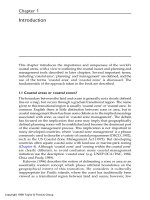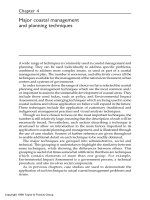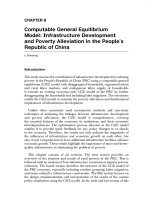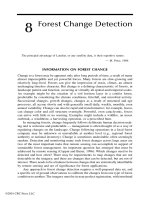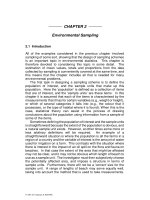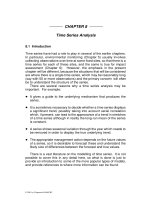Structure and Function in Agroecosystem Design and Management - Chapter 8 ppt
Bạn đang xem bản rút gọn của tài liệu. Xem và tải ngay bản đầy đủ của tài liệu tại đây (211.12 KB, 16 trang )
CHAPTER 8
Species Structure and Abundance
of Invertebrate Natural Enemies in
Sustainable Agroecosystems
Hiroshi Amano
CONTENTS
Introduction. . . . . . . . . . . . . . . . . . . . . . . . . . . . . . . . . . . . . . . . . . . . . . . . . . . . . 167
Nature of Species Structure and Abundance of Predacious
Phytoseiid Mites . . . . . . . . . . . . . . . . . . . . . . . . . . . . . . . . . . . . . . . . . . . . . . 170
Geographical and Climatic Factor . . . . . . . . . . . . . . . . . . . . . . . . . . . . 170
Food Habits and Co-occurring Prey Species . . . . . . . . . . . . . . . . . . . 171
Physical and Chemical Factors of Host Plant. . . . . . . . . . . . . . . . . . . 171
General Pattern of Dominancy in Phytoseiid Fauna. . . . . . . . . . . . . 173
Attributes of Mite Species Commonly Found in Agroecosystems and
Factors Affecting their Abundance . . . . . . . . . . . . . . . . . . . . . . . . . . . . . . 175
Phytoseiid Fauna in North American Apple Orchards . . . . . . . . . . 176
Pesticide Application as Ultimate and Proximate Factors . . . . . . . . 178
Cultural Practice as Ultimate and Proximate Factors . . . . . . . . . . . . 179
Change in Prey Fauna as a Proximate Factor. . . . . . . . . . . . . . . . . . . 179
Competitive Interaction as an Ultimate Factor . . . . . . . . . . . . . . . . . 180
Use of Natural Enemies in Sustainable Agroecosystems as
Concluding Remarks . . . . . . . . . . . . . . . . . . . . . . . . . . . . . . . . . . . . . . . . . . 181
References . . . . . . . . . . . . . . . . . . . . . . . . . . . . . . . . . . . . . . . . . . . . . . . . . . . . . . 181
INTRODUCTION
Recent expansion of the integrated pest management (IPM) system has
revolutionized the whole concept of crop protection not only in Japan but
167
0-8493-0904-2/01/$0.00+$.50
© 2001 by CRC Press LLC
920103_CRC20_0904_CH08 1/13/01 10:56 AM Page 167
168 STRUCTURE AND FUNCTION IN AGROECOSYSTEMS DESIGN AND MANAGEMENT
Table 8.1 Major Natural Enemies of Spider Mites in Agroecosystems of
Japan
Class Order Family Genus & Species
Insecta
Coleoptera Coccinellidae
Stethorus japonicus
Staphylinidae Oligota kashmirica benefica
Oligota yasumatsui
Diptera Cecidomyiidae Feltiella sp.
Hemiptera Anthocoridae Orius minutus
Orius nagaii
Orius sauteri
Neuroptera Chrysopidae Chrysopa pallens
Tysanoptera Thripidae Scolothrips takahashii
Arachnida
Acari Phytoseiidae
Amblyseius californicus
Amblyseius eharai
Amblyseius womersleyi
Typhlodromus vulgaris
others
Stigmaeidae
Agistemus exsertus
Agistemus terminalis
also in other areas of the world. Consequently, applied entomologists and
fundamental ecologists enjoy unexpected favor at all levels, not only to boost
crop yield but also to preserve nature. For a long time, the nature of biotic
interactions has been undiscovered and hidden in agricultural lands by
heavy use of agrochemicals. Japan, one of the leading producers of these
chemicals, unfortunately has taken the lead in throwing them into various
facets of agroecosystems, where a rich biotic fauna of the temperate zone was
originally established.
A unique problematic example showing this process is a fauna of natural
enemies of notorious pest mites. It is a well-known fact that spider mites were
not of primary importance in pest management prior to the intensive intro-
duction of synthetic agrochemicals in the 1960s. Mites had been well under
control by a complex of natural enemies, paradoxically proven by many
observations in which cessation of using pesticides and acaricides quickly
recovered natural enemies resulting in suppression of the mite population at
low levels. Due to persistent use of many chemicals, however, potential nat-
ural enemy fauna, especially in the 1960s and 1970s, was undiscovered com-
pletely, and it remained obscured until today. An overall picture of natural
enemy fauna for spider mites is composed of predacious insects and mites
(Table 8.1). These two taxa often co-occur in the field and together play an
important role in depressing prey population. Although there are some dif-
ferences in their predacious and habitat characteristics (Table 8.2), both
groups share a common weakness against most agrochemicals. Under these
circumstances, few long-tem studies on their dynamics in sustainable as well
920103_CRC20_0904_CH08 1/13/01 10:56 AM Page 168
SPECIES STRUCTURE AND ABUNDANCE OF INVERTEBRATE NATURAL ENEMIES 169
Table 8.2 Biological Characteristics of Natural Enemies of Spider Mites Common in Japan
Thripidae
Parameters Phytoseiidae Cecidomyiidae Staphylinidae Coccinellidae Chrysopidae
Body size Small Large
Abundance High Low
Predation rate Low High
of individual
Developmental Fast Slow
rate
Prey requirement Small Large
of individual
Stability in prey High Low
colony
920103_CRC20_0904_CH08 1/13/01 10:56 AM Page 169
as conventional agroecosystems are available, and analysis of factors respon-
sible for their abundance is lacking.
With the increasing emphasis on biological control as a core component
in IPM, there is an urgent need to understand biocontrol agents with respect
to the prevailing agroecosystem. This chapter focuses on the species structure
and abundance of predacious mites of the family Phytoseiidae in Japan, fol-
lowed by investigation into possible factors that determine their existence in
the field. Given results and hypotheses may be helpful in understanding and
predicting the behavior of natural enemies in upcoming sustainable agro-
ecosystems.
NATURE OF SPECIES STRUCTURE AND ABUNDANCE OF
PREDACIOUS PHYTOSEIID MITES
As mentioned briefly in the previous section, members of the family
Phytoseiidae show a remarkable ability to depress spider mite population by
their good numerical response and high stability in prey colony. Their body
size (about 0.4 mm for the largest adult female) is as small as prey mites, but
they are able to attack all stages of spider mites, although details of their bio-
logical attributes are species-specific (e.g., McMurtry et al., 1970). About 1600
species are known to occur in the world (Chant and McMurtry, 1994).
Recently, Ehara and Amano (1998) reviewed Japanese phytoseiid fauna and
nominated, in total, 77 species with short remarks on their biology. They also
categorized phytoseiid fauna into several groups after a close investigation of
their association with different food habits and habitat. In reference to the
basic picture presented by these authors, factors that may influence phyto-
seiid distribution and survival, especially in natural ecosystems, are
described in the following section. Certainly, these factors act simultaneously
in the field, but for clarification are explained separately below.
Geographical and Climatic Factor
The climatic conditions in Japan are somewhat hostile for the establish-
ment of beneficial phytoseiid species of tropical or subtropical origin, which
include members in the genus Phytoseiulus. Moreover, no Galendromus and
Metaseiulus species have been found. These two genera are of major taxa in
the subfamily Typhlodrominae in the New World (Chant and McMurtry,
1994; Ehara and Amano, 1998). Looking at domestic phytoseiids, two species
with similar ecological niches show contradictory distribution: Amblyseius
finlandicus is well distributed in northern or elevated areas of Japan, whereas
A. sojaensis is normally found in southern Japan. Some geographical and
associated climatic conditions must have played an important role in their
survival and establishment, and species seen in agroecosystems are not
exceptional in this matter.
170 STRUCTURE AND FUNCTION IN AGROECOSYSTEMS DESIGN AND MANAGEMENT
920103_CRC20_0904_CH08 1/13/01 10:56 AM Page 170
Food Habits and Co-occurring Prey Species
No species have exactly the same food requirement and prey preference,
and thus it is understandable that prey availability and distribution may
determine establishment of predacious mites. Even on the same host plant,
different fauna of phytoseiid mites will become dominant if prey species are
changed with some reasons. One of the important factors in this regard is
webbings produced by spider mites. Heavy web structures constructed by
Tetranychus spp., in particular, easily eliminate certain phytoseiid species
from the field, and often simplified their fauna (discussed in later sections).
Table 8.3 shows a general scheme of four phytoseiid genera adapting to dif-
ferent food types. It seems that there is a trend of increasing dependability on
animal food along the genus line of Phytoseius-Typhlodromus-Amblyseius-
Phytoseiulus. Of course, exceptional species can be found among various
genus. In agroecosystems, abrupt turnover of prey species complex is often
caused by human manipulations such as spray application.
Physical and Chemical Factors of Host Plant
The use of the term host plant for natural enemies is misleading because
it is not purely phytophagous, but, for convenience, this word is used
throughout this chapter for the plant on which the mites are collected. The
physical structure on plant surfaces unexpectedly influences the successful
colonization of phytoseiid mites. Leaf structure may includes roughness,
pubescence, vein structure, domatium, and others (e.g., Collyer, 1976; Walter
and O’Dowd, 1992). It is also suggested that volatile chemicals of host plants
sometimes play a key role in the trophic triangle of host plant-prey mite-
predacious mite (e.g., Dicke et al., 1990).
Physical and chemical factors of host plants may also affect food prefer-
ence and colonization of spider mites, and thus it is sometimes difficult to
identify the ultimate reasons, between changes in prey species and host
plants, for turnover of phytoseiid fauna. Nevertheless, Table 8.4 summarizes
dominant phytoseiid species, which attack the population of a spider mite,
Tetranychus kanzawai, in Japan for each host plant separately. Among these
plants, basic fauna of predators is similar, but the predominant species on
each plant (shown in the order of their abundance in the table) show some
differences. For example, A. womersleyi commonly dominates on tea and
Kudzu vine, but it is replaced by A. eharai on hydrangea and Glory-Bower.
Distribution of predacious mites shows subtle differences even on the
same tree. In 1988, mites were collected throughout seasons from water
sprouts of Japanese pear trees in a small experimental orchard, and species
were identified (Table 8.5). Due to unsprayed conditions for more than 10
years, a rust mite, Eriophyes chibaensis, is the only prey source for predators on
both leaves and twigs of the sprouts. These phytoseiid species lived under
the same climatic conditions and associated with the same prey, but they
SPECIES STRUCTURE AND ABUNDANCE OF INVERTEBRATE NATURAL ENEMIES 171
920103_CRC20_0904_CH08 1/13/01 10:56 AM Page 171
172 STRUCTURE AND FUNCTION IN AGROECOSYSTEMS DESIGN AND MANAGEMENT
Table 8.3 Generalized Food Types and Biological Characteristics of Four Phytoseiid Genera
Parameters Food Types
Light Webbing Heavy Webbing
Plant Juice Pollen Rust mite Spider Mite Spider Mite
Phytoseius
Typhlodromus
Amblyseius
Phytoseiulus
Developmental rate Low High
Predation rate Low High
Oviposition rate Low High
Stability of population High Low
920103_CRC20_0904_CH08 1/13/01 10:56 AM Page 172
showed some discrepancies in species abundance between leaves and twigs
on the same sprouts. It was assumed at least that certain plant morphology
and physiology might have affected microhabitat selection of each species in
the field.
General Pattern of Dominancy in Phytoseiid Fauna
Is there any general pattern in phytoseiid fauna under relatively undis-
turbed environments? This question is a topic in the present section and
includes information useful when sustainable agroecosystems are once
established. In Table 8.6, species structures of phytoseiid mites are shown as
percentages for several natural or seminatural ecosystems. Three dominant
species on each host plant occupied 67 to 99% of all specimens, and in two
cases two dominant species accounted for over 90% (Kudzu vine and cherry
in Matsudo). These values suggest that in undisturbed conditions, two or
three species co-occupy the habitat and share resources in the single season.
SPECIES STRUCTURE AND ABUNDANCE OF INVERTEBRATE NATURAL ENEMIES 173
Table 8.4 Dominant Phytoseiid Species in Japan Attacking Tetranychus
kanzawai on Different Host Plants
Host Plant Phytoseiid Species
Japanese pear Amblyseius californicus, Amblyseius womersleyi
Te a Amblyseius womersleyi, Amblyseius californicus
Hydrangea Amblyseius eharai, Amblyseius womersleyi
Kudzu vine Amblyseius womersleyi, Amblyseius eharai, Amblyseius sojaensis
Glory-Bower Amblyseius eharai, Amblyseius womersleyi, Amblyseius orientalis
Species are arranged in the order of their abundance.
Table 8.5 Species Structure and Abundance of Phytoseiid Mites on Water
Sprouts of Nonsprayed Japanese Pear Trees
Species (no. of adult females and % in parentheses)
On Leaves (n ؍ 145) On Twigs (n ؍ 41)
1. Amblyseius sojaensis 74(51) 1.Typhlodromus serrulatus 18(44)
2.
Typhlodromus vulgaris 29(20) 2. Typhlodromus vulgaris 9(22)
3.
Amblyseius okinawanus 19(13) 3. Amblyseiulella amanoi 4(10)
4.
Amblyseiulella amanoi 13(9) 4. Amblyseius sojaensis 3(7)
5.
Amblyseius tsugawai 7(5) 4. Amblyseius okinawanus 3(7)
6.
Amblyseius eharai 3(2) 6. Amblyseius orientalis 2(5)
7.
Amblyseius tsugawai 1(2)
7. Amblyseius makuwa 1(2)
Surveys were conducted on 20 sampling dates in 1988 in an unsprayed small experimental
orchard in Chiba Prefecture, central Japan. Predacious mites on different parts of water
sprouts were separately collected and identified.
920103_CRC20_0904_CH08 1/13/01 10:56 AM Page 173
174 STRUCTURE AND FUNCTION IN AGROECOSYSTEMS DESIGN AND MANAGEMENT
Table 8.6 Percentage Occupancy of Dominant Phytoseiid Species in Natural or Seminatural Ecosystems in Japan
Host Plant (date & place) n Percentage Occupancy of Dominant 3 Species
Kudzu vine (1984 in Matsudo, Chiba) 96 Amblyseius womersleyi (49), Phytoseius nipponicus (42), Amblyseius tsugawai (6)
Kudzu vine (1987–89 in Togane, Chiba) 240
Amblyseius okinawanus (63), Phytoseius nipponicus (12), Amblyseius tsugawai (11)
Glory-Bower (1998 in Togane, Chiba) 267
Amblyseius orientalis (40), Amblyseius okinawanus (39), Amblyseius eharai (13)
Cherry (1994 in Matsudo, Chiba) 229
Typhlodromus vulgaris (50), Amblyseius sojaensis (44), Typhlodromus serrulatus (5)
Japanese pear (1988 in Togane, Chiba) 307
Amblyseius soajaensis (44) Amblyseius okinawanus (22), Typhlodromus vulgaris (14)
Japanese pear (1995, in Kuki, Saitama) 68 Amblyseius okinawanus (26), Amblyseius californicus (25), Amblyseius paraki (16)
In all surveys, samplings were carried out weekly or fortnightly. All host plants were in unsprayed condition.
920103_CRC20_0904_CH08 1/13/01 10:56 AM Page 174
In other words, this pattern could be an attribute that belongs to the phyto-
seiid community in common.
The species structure and abundance shown in Table 8.6 calculations
were based on all specimens collected on the host plants during the survey
season, and, thus, in some cases a seasonal discrepancy in abundance did not
appear. The dominant phytoseiid species was dramatically changed on
cherry in spite of year-round occurrence of the prey mite Tet. viennensis
(Figure 8.1). Factors responsible for this seasonal change are not fully under-
stood, and therefore further investigation is necessary.
ATTRIBUTES OF MITE SPECIES COMMONLY FOUND IN
AGROECOSYSTEMS AND FACTORS AFFECTING THEIR
ABUNDANCE
Among 77 species recorded from Japan (Ehara and Amano, 1998), 14
species are relatively common in a variety of agroecosystems (Table 8.7).
Under the present pest management system, chemical control dominates
other tactics of crop protection. Phytoseiid species, which successfully sur-
vive in such conditions, have some potential of pesticide tolerance.
Furthermore, pest mites of the genera Tetranychus and Panonychus usually
increase their numbers by resurgence, and thus predators in close relation to
SPECIES STRUCTURE AND ABUNDANCE OF INVERTEBRATE NATURAL ENEMIES 175
Figure 8.1 Seasonal population dynamics of two dominant phytoseiid species on
cherry trees in Matsudo, Chiba, Japan in 1994. They were closely asso-
ciated with a prey mite, Tetranychus viennensis.
920103_CRC20_0904_CH08 1/13/01 10:56 AM Page 175
these prey may have advantages. As pointed out earlier, ability of phytoseiid
species to be generous with spider mite webbing is a precious talent to
increase their population in available prey resources, especially against
genus Tetranychus. All species of Phytoseius and Typhlodromus and many
species of Amblyseius listed in Table 8.7 lack at least one of these abilities.
Japan, extending north to south, is a country with extreme variations in
climate, and climatic conditions in the northern area are supposed to be
severe for the survival of most species. Cold tolerance and overwintering
ability are important characteristics for species survival as shown for A. wom-
ersleyi by Kishimoto and Takafuji (1994 and 1997). They showed that popula-
tions from the north had higher diapausing capacity than the southern
population but at the expense of a narrower temperature range in which they
could display their full reproductive ability. In the following section, details
of factors that affect the abundance of phtyoseiid mites in agroecosystems are
described.
Phytoseiid Fauna in North American Apple Orchards
Surveys on apple trees in the “apple belt” of North America are by far the
most complete among any studies for phytoseiid fauna on a single host plant.
Those from the 1960s and 1970s are especially useful because few exotic
species were experimentally introduced into the areas in those eras. Table 8.8
shows dominant species in the eastern, central, and western regions of the
apple belt for sprayed and unsprayed orchards separately. In commercial
sprayed orchards, A. fallacis predominated in 14 states and provinces of east-
ern and central regions, whereas in five western states and provinces
Typhlodromus occidentalis predominated.
When crop protection practices including sprays were discontinued, more
species were observed in the orchards, and this trend was common in all apple
orchard regions of North America. In the eastern to central regions, T. pomi
became most abundant and widely distributed. Phytoseius macropilis seems to
have a second position in this context. In the west, however, T. caudiglans and
T. pyri (in British Columbia) or T. flumenis (in Utah), for example, dominated
in the orchards, and T. pomi was never as numerous as in other regions.
176 STRUCTURE AND FUNCTION IN AGROECOSYSTEMS DESIGN AND MANAGEMENT
Table 8.7 Phytoseiid Species Commonly Found in Japanese Agroecosystems
Genus No. of Species Species Name
Phytoseius 2 capitatus, nipponicus
Typhlodromus
2 serrulatus, vulgaris
Amblyseius
10 californicus, eharai, finlandicus,
koyamanus, makuwa, okinawanus,
orientalis, sojaensis, tsugawai,
womersleyi
Species were collected from agricultural crops and/or groundcovers.
920103_CRC20_0904_CH08 1/13/01 10:56 AM Page 176
Based on the results shown here and other studies, a generalized dia-
gram showing overall relationships of factors that possibly change phyto-
seiid fauna in agroecosystems is described in Figure 8.2. For simplicity, any
changes originating from climatic factors were excluded from the diagram.
Three factors are assumed as major components of the ultimate factor: pesti-
cide application, cultural practice, and competitive interaction between
species. In the figure, a proximate factor is also inserted: change in prey
fauna. Pesticide application certainly operates as the most influential factor
in the field either directly (killing predators) or indirectly (killing certain prey
species). Cultural practice of crops, such as weed management, also deter-
mines abundance of predators directly or indirectly. In contrast, competi-
tive interaction among predators is not well understood, but it is probably
SPECIES STRUCTURE AND ABUNDANCE OF INVERTEBRATE NATURAL ENEMIES 177
Table 8.8 Dominant Phytoseiid Species in North American Apple Orchards
Regions Commercial (sprayed) Unsprayed or Abandoned
Eastern and central Amblyseius fallacis Typhlodromus pomi
Typhlodromus pyri Phytoseius macropilis
Typhlodromus caudiglans Typhlodromus caudiglans
Typhlodromus longipilus
Amblyseius finlandicus
Western Typhlodromus occidentalis Typhlodromus pyri
Typhlodromus citri Typhlodromus flumenis
Typhlodromus arboreus Amblyseius cucumeris
Phytoseius macropilis
Typhlodromus caudiglans
Typhlodromus citri
Amblyseius andersoni
After Amano (1985).
Species are arranged in the order of their abundance.
Figure 8.2 Diagrammatic representation showing factors responsible for change in
phytoseiid fauna in the field.
920103_CRC20_0904_CH08 1/13/01 10:56 AM Page 177
important in this context, as will be mentioned later. Details of these factors
are discussed in the following sections.
Pesticide Application as Ultimate and Proximate Factors
Many studies suggested drastic changes in species structure and abun-
dance of phytoseiid species by applications of various pesticides and acari-
cides in the field. Some examples in apple orchards include Hoyt and
Caltagirone (1971), Knisley and Swift (1972), Croft and Jorgensen (1977),
Penman et al. (1979), Hill and Foster (1998), and Lester et al. (1999).
Populations of both phytoseiid and prey mites were severely damaged by
spray applications, but it is well known that predator populations suffer
more influence due to their lower tolerance to chemicals. Consequently, mite
community in the field is completely changed, and this often leads to out-
breaks of spider mites (resurgence).
Figure 8.3 shows seasonal dynamics of phytoseiid mites in 1994 on
sprayed and unsprayed cherry trees. Significant reduction in numbers of
phytoseiids was evident on the sprayed trees and the spider mite population
on the trees reached a peak more than two times as high as that on the
unsprayed trees.
178 STRUCTURE AND FUNCTION IN AGROECOSYSTEMS DESIGN AND MANAGEMENT
20
15
10
5
5678910
0
Month in 1994
No. of mites/100 leaves
Unsprayed
Sprayed
Figure 8.3 Seasonal population dynamics of phytoseiid species on cherry trees
under sprayed and unsprayed conditions in Matsudo, Chiba, Japan in
1994. The numbers of two dominant species, preying on Tetranychus
viennensis, were combined. Sprays were applied twice on Jun. 6 and
Aug. 15, after the mite surveys, with Parmathion WP (ϫ1,000; 10
liters/tree).
920103_CRC20_0904_CH08 1/13/01 10:56 AM Page 178
Cultural Practice as Ultimate and Proximate Factors
In orchard agroecosystems, application and degree of weed control may
contribute much to the abundance of spider mites and their natural enemies.
Spider mite species such as Tet. urticae are considered to overwinter on the
groundcovers as well as on the trees in Japan. Phytoseiid species commonly
found on herbaceous host plants also survived on the ground level in winter,
and, if weed control in orchards is light throughout seasons, their popula-
tions are maintained at high levels and predators often climb on the trees.
Amblyseius tsugawai is one of those species, and it is frequently observed in
sod-cultured orchards.
Different cultural practices undoubtedly affect many dimensions and
components in the agricultural land, and thus it is usually difficult to pin down
the exact cause of any change in phytoseiid fauna. However, well-planned
elaborate experimental work should solve this problem in the near future.
Change in Prey Fauna as a Proximate Factor
In the context discussed above, if prey mite fauna changes with reasons
described in the previous sections, most probably predator fauna also changes.
A close association of particular spider mite and phytoseiid mite species sup-
ports this hypothesis. In Figure 8.4, phytoseiid fauna in 3 Japanese pear
orchards is shown. These orchards were either completely unsprayed or
lightly sprayed and had similar groundcovers by sod-cultured practices.
Different prey mites predominated in each orchard (refer to the figure legend),
and accordingly phytoseiid fauna showed remarkable differences. It should
be noted, however, that prey fauna itself is probably a proximate factor and
ultimate factors such as pesticide and cultural practice usually exist; these
ultimate factors possibly operate directly as a proximate factor (Figure 8.3).
Unfortunately, these interactions are often difficult to separate.
SPECIES STRUCTURE AND ABUNDANCE OF INVERTEBRATE NATURAL ENEMIES 179
20
14
22
44
20
13
16
25
26
13
87
T. vulgaris
A. sojaensis
A. okinawanus
A. okinawanus
A. paraki
A. californicus
A. tsugawai
A. eharai
Togane, Chiba (n=307)
Kuki, Saitama (n=68)
Chiba, Chiba (n=144)
Figure 8.4 Species structure (% occupied) of phytoseiid species in Japanese pear
orchards with different prey mites in dominance. Main prey mites and
observation years are as follows: Eriophyes chibaensis in 1988 (Togane),
Tetranychus kanzawai in 1995 (Kuki), and Panonychus citri in 1996
(Chiba).
920103_CRC20_0904_CH08 1/13/01 10:56 AM Page 179
Competitive Interaction as an Ultimate Factor
Discussion on this subject is limited because little empirical data and
knowledge are available. Amano (1985) suggested from the survey on phy-
toseiid fauna in North American apple orchards that there was a tendency
that a single species dominated in each orchard and that when two or more
species co-occurred they usually had different ecological requirements and
dissimilar morphological characteristics. Discussion along this line was also
proposed by Specht (1968).
In Japan, a recent expansion in distribution of A. californicus is evident on
many host plants that are infected by Tetranychus prey mites. This phytoseiid
species was assumed to invade commercial Japanese pear orchards in central
Japan in the late 1980s and has threatened the dominant position once occu-
pied by A. womersleyi. In Figure 8.5, phytoseiid fauna in 4 neighboring
orchards is shown. These orchards are owned by different farmers. However,
the orchards were managed under the same spraying and weed control
guidelines proposed by the prefectural government and thus shared the
same pest spider mite Tet. kanzawai. Amblyseius californicus predominated in
two orchards and A. womersleyi overwhelmed in the others. Results sug-
gested that some competitive forces had operated between two species,
although the possible presence of other ultimate and/or proximate factors
could not be fully excluded.
180 STRUCTURE AND FUNCTION IN AGROECOSYSTEMS DESIGN AND MANAGEMENT
17
19
83
81
71
91
9
29
A. californicus
A. womersleyi
A. tsugawai
Figure 8.5 Species structure (% occupied) of phytoseiid species in 4 neighboring
pear orchards under similar cultural conditions. Survey was conducted
on Aug. 28, 1997 at Katori, Chiba.
920103_CRC20_0904_CH08 1/13/01 10:56 AM Page 180
USE OF NATURAL ENEMIES IN SUSTAINABLE
AGROECOSYSTEMS AS CONCLUDING REMARKS
In consideration of sustainable agroecosystems, establishment of the IPM
program for major pests is a key step, and without this sustainable program
any success will be short-lived. Accordingly, to plan an IPM program, atten-
tion should be paid to various natural enemies in the field. This environment
is especially critical in control of spider mites because a rich fauna of natural
enemies preexisted for these pest species. Whatever the factors responsible
for changes in natural enemy populations, and however they actually behave
in the field, we must conserve and use a capacity of their ability in regulating
the prey population. A continuous use of synthetic pesticides and acaricides
kept natural enemies out of agricultural lands, and we are now facing a seri-
ous problem in the names of resurgence and environmental pollution.
Ecologically speaking, frequent chemical applications introduced never-end-
ing instability into agroecosystems, and natural enemies of spider mites suf-
fered a great reduction in numbers.
It is obvious that not only spider mites are the major pests in the field, but
a complex of hazardous invertebrates also inhabit. The goal of an IPM pro-
gram should be an integrated one that covers all major pests in the field. In
Chiba prefecture, central Japan, we have been investigating for the last sev-
eral years the successful establishment of the IPM system in which major pest
groups of Japanese pear (aphids, spider mites, and caterpillars of leafrollers
and fruit moths) should be systematically managed. As a basic philosophy in
the program, Lepidopterans are managed by use of pheromone traps and
aphids are managed through natural enemies and selective pesticides. Under
these conditions, a population of native natural enemies (especially phyto-
seiid mites) successfully depresses spider mites. Any unstable sources, such
as powerful wide-spectrum sprays against caterpillars and aphids, are
explicitly omitted from the system. Long-term investigation of the program
is now under execution.
Since 324 BC in China, when ancient Chinese farmers were reported to
foster ants in order to control caterpillars and beetles on citrus trees (after
DeBach and Rosen, 1991), there has been pessimism about development
in our technology of biocontrol and related philosophy on pest management.
However, an assignment recently given to us in the name of sustainable agri-
culture broke the deadlock and opened a new dimension. We must therefore
face the problem with an old man’s wisdom and a new man’s weapon (sci-
ence) to establish a sustainable society as well as agroecosystems. What we
need now is not antagonistic but real, harmonious views in pest control.
REFERENCES
Amano, H., 1985. Some Aspects of the Ecology of Acarina on Abandoned Apple Trees
in Ontario, Canada. Ph.D. thesis, University of Toronto, Ontario, Canada, 220.
SPECIES STRUCTURE AND ABUNDANCE OF INVERTEBRATE NATURAL ENEMIES 181
920103_CRC20_0904_CH08 1/13/01 10:56 AM Page 181
Chant, D. A. and McMurtry, J. A., 1994. A review of the subfamilies Phytoseiinae and
Typhlodrominae (Acari: Phytoseiidae).
Int. J. Acarol., 20:223–310.
Collyer, E., 1976. Integrated control of apple pests in New Zealand. 6. Incidence of
European red mite,
Panonychus ulmi (Koch), and its predators. N. Z. J. Zool.,
3:39–50.
Croft, B. A. and Jorgensen, C. D., 1977.
Typhlodromus mcgregori Chant (Acarina:
Phytoseiidae) and its control of phytophagous mites in Utah and southern
California apple orchards.
Great Basin Nat., 37:366–374.
DeBach, P. and Rosen, D., 1991.
Biological Control by Natural Enemies (2nd ed.).
Cambridge University Press, New York, 440.
Dicke, M., Van Beek, T. A., Posthumus, M. A., Ben Dom, N., Van Bokhoven, H., and
de Groot, A. E., 1990. Isolation and identification of volatile kairomone that affects
acarine predator-prey interactions.
J. Chem. Ecol., 16:381–396.
Ehara, S. and Amano, H., 1998. A revision of the mite family Phytoseiidae in Japan
(Acari, Gamasina), with remarks on its biology.
Species Diversity, 3:25–73.
Hill, T. A. and Foster, R. E., 1998. Influence of selective insecticides on population
dynamics of European red mite (Acari: Tetranychidae), apple rust mite (Acari:
Eriophyidae), and their predator
Amblyseius fallacis (Acari: Phytoseiidae) in apple.
J. Econ. Entomol., 91:191–199.
Hoyt, S. C. and Caltagirone, L. E., 1971. The developing programs of integrated con-
trol of pests of apples in Washington and peaches in California, in
Biological
Control,
Huffaker, C. B. (Ed), Plenum Press, New York, 396–421.
Kishimoto, H. and Takafuji, A., 1994. Variations in the diapause characteristics of
Amblyseius womersleyi Schicha (Acari: Phytoseiidae). J. Acarol. Soc. Japan., 3:59–67.
Kishimoto, H. and Takafuji, A., 1997. Variations in the life-history parameters among
populations of
Amblyseius womersleyi Schicha with different diapause characteris-
tics (Acari: Phytoseiidae).
Appl. Entomol. Zool., 32:395–401.
Knisley, C. B. and Swift, F., 1972. Qualitative study of mite fauna associated with apple
foliage in New Jersey.
J. Econ. Entomol., 65:445–448.
Lester, P. J., Pree, D. J., Thistlewood, H. M. A., Trevisan, L. M., and Harmsen, R., 1999.
Pyrethroid encapsulation for conservation of acarine predators and reduced spi-
der mite (Acari: Tetranychidae) outbreaks in apple orchards.
Environ. Entomol.,
28:72–80.
McMurtry, J. A., Huffaker, C. B. and Van de Vrie, M., 1970. Ecology of tetranychid
mites and their natural enemies: a review. I. Tetranychid enemies: their biological
characters and the impact of spray practices.
Hilgardia, 40:331–390.
Penman, D. R., Wearing, C. H., Collyer, E. and Thomas, W. P., 1979. The role of insec-
ticide-resistant phytoseiids in integrated mite control in New Zealand.
Recent
Adv. in Acarology,
1:59–69.
Specht, H. B., 1968. Phytoseiidae (Acarina: Mesostigmata) in the New Jersey apple
orchard environment with descriptions of spermathecae and three new species.
Can. Entomol., 100:673–692.
Walter, D. E. and O’Dowd, D. J., 1992. Leaf morphology and predators: effect of leaf
domatia on the abundance of predatory mites (Acari: Phytoseiidae).
Environ.
Entomol.,
21:478–484.
182 STRUCTURE AND FUNCTION IN AGROECOSYSTEMS DESIGN AND MANAGEMENT
920103_CRC20_0904_CH08 1/13/01 10:56 AM Page 182


